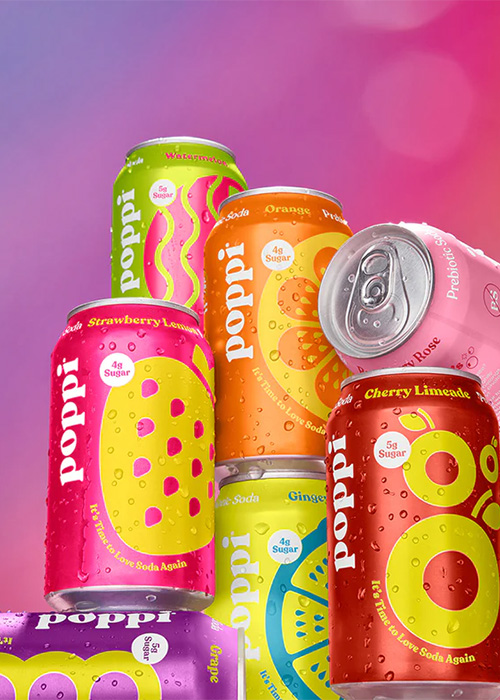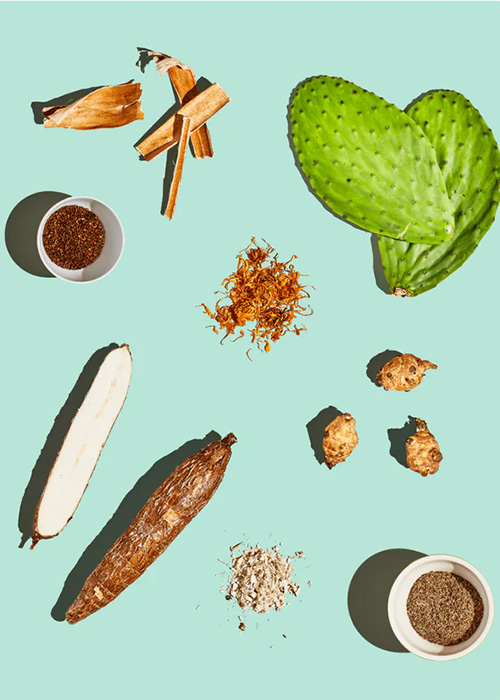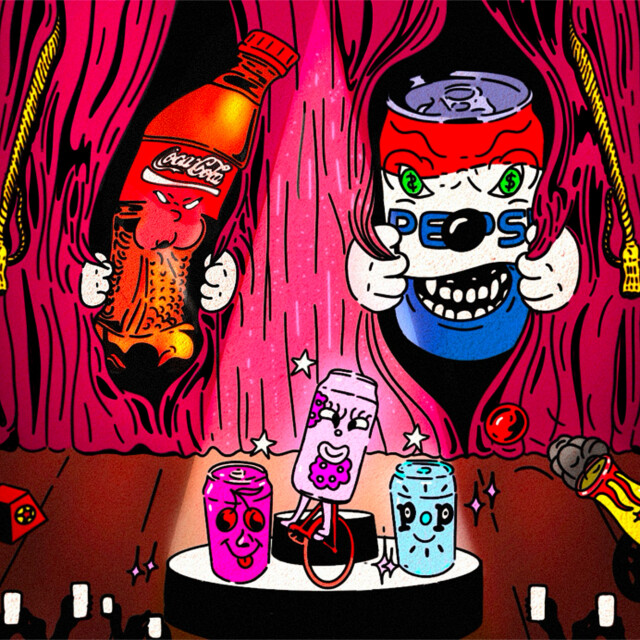When the numbers dropped for this year’s most watched Super Bowl ads, it wasn’t a usual suspect, like Doritos or Bud Light, at the top. Instead, flashy craft soda brand Poppi reached more households (29.1 million) than any other ad that night. The company’s 60-second spot boldly proclaimed that moment would be the last one “you ever think of soda as being a dirty word.”
“This will be the soda,” the narrator says, “your kids and grandkids think of when they think of soda.” Amid old-school footage of original cars and cell phones, interspersed with happy young people lifting colorful cans of Poppi, and a monologue about the power of fresh ideas, the commercial, which the brand titled “The Future of Soda Is Now,” closes with the hashtag #sodasback.
Soda never truly went away, most would argue. But its influence has faded as prices rise, customers (especially younger ones) pay more attention to health, and new options, like sparkling water or energy drinks, find their way to refrigerators. Now, brands like Poppi (which includes prebiotics, apple cider vinegar, and five 5 grams of sugar per 12-ounce serving) are elbowing their way into an industry long dominated by two main characters: Coca-Cola and Pepsi.
“Our customers — and consumers in general — are seeking alternatives to traditional sodas,” co-founder and chief brand officer Allison Ellsworth says in an email. “By using better-for-you ingredients and offering a wide variety of refreshing and delicious flavors, Poppi is giving consumers the freedom to love soda again.”
The Super Bowl spot clearly appealed to someone looking for that freedom: Poppi’s Google search traffic increased 100 times in the hour after the ad ran, and its Instagram saw a 250 percent bump in engagement. It was a commanding entrance onto the national scene — albeit one that had been bubbling up for several years. What started as Mother Beverage in 2018 (as seen on “Shark Tank” ) had become one of the most visible better-for-you soda brands driving a shift in the soda culture.
That visibility is pretty literal. Poppi’s website is a psychedelic fever dream — all effervescent fonts and neon pinks and yellow. Celebrities ranging from Russell Westbrook and Olivia Munn (who joined an investment group funding the brand) to Billie Eilish (who keeps cans backstage) have been seen with Poppis.
Recently, there’s been (legal) doubt cast on the true potency of Poppi’s ingredients. This month, the company was slapped with a class-action lawsuit alleging that Poppi was “basically sugared water” and that consumers would need to drink four cans a day to receive any actual gut-health benefit. Nutrition experts also say that simply eating an apple provides the same level of fiber as a Poppi.
But an apple doesn’t quite have the same pop on Instagram.
Poppi’s bright, fun aesthetic — mixed with those purportedly healthier ingredients — is part of a larger trend of craft soda brands making a splash in soda culture. There’s Culture Pop, which uses live probiotics and is kosher, vegan, and non-GMO. The brand tripled its retail distribution footprint from 2020 to 2023 and is carried at major chains like Whole Foods and Walmart. And there’s Olipop, which cleared $200 million in sales last year, and is projected to more than double that in 2024.

“This is going to change the world,” Olipop head of growth Steven Vigilante remembers thinking when he first joined the company. “If it tastes good.”
That balance — between offering a healthier product, while still maintaining the taste that consumers expect from a soda — is one the emerging craft brands are trying to strike.
“Younger consumers are looking and saying, ‘I want something better. I don’t want 160 calories and 50 grams of sugar.’”
Given the state of the industry, there might be no time like the present to pop the top on something new. Consumption of carbonated soft drinks has been on the decline in the U.S. since the early 2000s and even reached a 30-year low in 2016. Still, “bubbles are kind of like the Holy Grail,” says Culture Pop founder Tom First, although with the recent rise of non-carbonated drinks, that appreciation for bubbles — especially from the younger generation — could be shifting.
If there’s going to be a future of soda that isn’t so dominated by traditional red and blue, these younger craft brands have something to say about how to paint that new picture.
How Did We Get Here?
Soda as a concept has already experienced massive evolutions over its lifespan. Famously, Coca-Cola’s original recipe included coca leaves. 7-Up was made with lithium — a popular psychiatric treatment — taking the idea of an afternoon mood booster to a new level.
While soda may have gotten rid of the harder drugs, it’s never quite been able to shake the “unhealthy” label. Calorie count and sugar content are big reasons. A 12-ounce serving of original Pepsi or Coke contains 150 calories. Even diet sodas have faced similar perception issues. Diet Coke uses aspartame, an artificial sweetener whose cancer risk is still being studied by the World Health Organization.
For millions of people, those downsides simply don’t matter. Coca-Cola’s 2023 revenues surpassed $45 billion. Pepsi, which owns several food brands in addition to beverages, had more than $91 billion in 2023 revenue.
To lifetime customers, nothing tastes like a Coke or Pepsi — and drinking one is as much cultural participation as individual refreshment. These drinks have been woven into the fabric of American society for decades. People have Coca-Cola theme rooms in their houses. Pepsi has partnered with cultural juggernauts ranging from Beyoncé to Madonna to Tina Turner. Anyone who grew up in the 1960s — or watched “Mad Men” — could tell you how much of a chokehold Coca-Cola’s marketing has had on the American public.
But as the energy of these younger brands fizzes upward and more soda marketing migrates to social media platforms where consumers want a personal connection with the brands they support, there’s a question of whether the industry’s heavyweights have the same momentum.
“Culturally, over the past few years this desire to feel good now has continued to grow.”
“The challenge is Coke, Pepsi, Mountain Dew trying to figure out how they remain relevant at a time when it’s about personal interaction that makes a difference,” says Neil Kimberley, a beverage industry consultant who’s previously worked with brands like RC Cola and Snapple.
Needless to say, Coke and Pepsi still hold relevance — and massive revenues. But is there a limit to that brand loyalty when the prices keep going up?
Coca-Cola boosted prices 13 percent across products in the first quarter of 2024 alone. Pepsi strung together eight consecutive quarters of double-digit percentage price increases. The soda industry is plagued by many of the same issues other sectors struggle with: cost of commodities, supply chain snags, cost of packaging, general inflation, and corporations flirting with a “how much can we get away with?” mentality.
The newer, trendier soda brands aren’t exactly a price break. A 12-pack of Poppi, Olipop, or Culture Pop could run you between $28 and $35. A 12-pack of Pepsi or Coke, meanwhile, is less than $10. But if that purchase can pack a flavorful punch and have some kind of health benefit, it can feel like money better spent.
“Younger consumers are looking and saying, ‘I want something better. I don’t want 160 calories and 50 grams of sugar,’” Culture Pop’s First says. “They didn’t grow up with a 2-liter on their kitchen table.”
Marketing to the New Soda Consumer
To a certain degree, this new wave of soda culture intersects with “little treat” culture — a TikTok trend, primarily driven by Gen Z’ers and millennials, in which people buy something inexpensive, like a bagel or a beverage, that makes them happy. The goal is to (moderately, within reason) reward themselves for checking off to-do items — but also to maintain tiny bursts of joy throughout the day, even if they have to trudge through an overflowing inbox.
Finish a tedious task like an expense report? Little treat. Clean out the junk drawer? Little treat. Indeed, little treats may have been consumed in the writing of this article.
Sodas, especially aesthetic ones that look good in a photo, can fit squarely into that philosophy. “Culturally, over the past few years this desire to feel good now has continued to grow,” says Hunter Thurman, president of Alpha-Diver, a market research firm that studies the psychology behind consumer behavior. “All the stress over the pandemic and all the shit has made people kind of go, ‘Screw it. I just want to have things like soda, fast food, snacks.’ They’re like a $3 vacation.”
Much of that trend is driven by younger generations. And those are demographics that craft brands are hitting hard, especially as consumers who grew up with that 2-liter at dinner start to age.
Olipop and other similar brands are leaning into the channels where these younger generations spend time, especially TikTok. Poppi, for example, recently teamed up with TikTok influencer Alix Earle to launch its new Lemon Lime flavor. The partnership involved an entire Poppi-themed house at Coachella — and resulted in one of Poppi’s biggest launches on record, according to Ellsworth.
For a generation like Gen Z that’s grown up with social media — and to a certain extent, mining their lives for daily content — a can of soda is easier to naturally integrate than other food items. The brands themselves are eager to insert themselves into that picture (or video).
“[Soda] is not something that needs to be cooked or thawed or frozen,” Olipop’s Vigilante says. “Even cereal, right? It’s hard to just hold a box of cereal versus soda is more like an accessory. Effectively, it could be in any piece of content.”

It’s a sea change in how sodas are marketed, especially compared to previous generations where communication channels were more limited.
“When the world was on TV, and then you built an enormous display in a store, and then when [the consumer] walked in the store, it was right in front of you, that is like gangster-level control over a category,” First says. “Social media and the internet and Instagram and TikTok have democratized information. If you don’t have $20 million to run a national campaign, you can still reach consumers and talk to them.”
That rise of social media has led to the rapid spread of more information — both accurate and not. But the platforms do at least make viewers aware of more choices than, say, that old-school grocery store display and a one-channel TV commercial.
According to Innova Marketing Insights, the top reason consumers gave for decreasing their soda consumption was “perceived unhealthiness” — but taste was still the primary driving factor for choosing soda. For brands that do claim some level of health benefits — whether probiotics, lower sugar count, or cleaner ingredients — the trick is to plug those benefits without beating consumers over the head with them.
Is the Future of Soda Now?
Coke and Pepsi have long since figured out a formula for taste and joy in a 12-ounce can. But as consumer preferences change, will they need to shift even more?
According to Kimberley, the industry consultant, traditional brands have started being more flexible with can sizes to reflect the audience’s desire for fewer calories. It’s about getting “the right packages and the right size to the right consumer in the right environment,” he says.
“I think if you go forward a few decades, it’s going to look as different as the change we’ve seen over the last couple decades.”
Another way to remain relevant amid shifts in consumer preference is, of course, simple acquisition. “If these products continue to grow, it’s likely the soda giants will either invest or acquire one of these brands, or introduce their own healthier soda product,” says Gary Hemphill, managing director of research at Beverage Marketing Corporation.
Whether that’s where this new wave of craft soda brands is headed remains to be seen. It’s a “very common playbook,” Thurman says, for smaller craft brands to start a company, build it up, and sell to one of the big dogs. Coke, for example, has acquired Minute Maid, Topo Chico, Fanta, and more. Pepsi bought up Gatorade, Lipton, SoBe, and SodaStream.
What does seem certain to most in the space is that grocery store aisles are shifting rapidly. At one point, those aisles almost exclusively had Coke, for example. Then came root beers, bottled iced teas, flavored waters, and more. Now, soda has more entrants into that space than ever.
That evolution has brought a kaleidoscope of whimsical packaging and feel-good ingredients. But that shift also represents the flurry of choices consumers now have access to if they want to rethink their soda experience. And those decisions will color the soda landscape of the future.
“If you looked at the different generations and imagined Gen Z being 50 or 60 and what they are going to be purchasing, … I think it’s going to change the face of the category,” First says. “I think if you go forward a few decades, it’s going to look as different as the change we’ve seen over the last couple decades.”
This story is a part of VP Pro, our free platform and newsletter for drinks industry professionals, covering wine, beer, liquor, and beyond. Sign up for VP Pro now!
